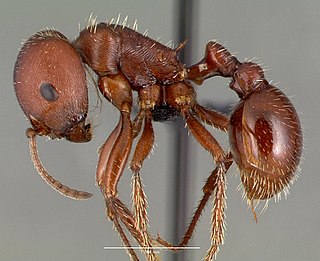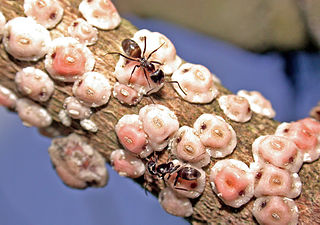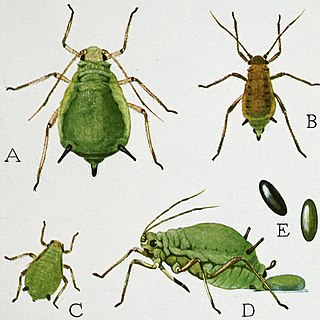
Pogonomyrmex is a genus of harvester ants, occurring primarily in the deserts of North, Central, and South America, with a single endemic species from Haiti.

Dolichoderinae is a subfamily of ants, which includes species such as the Argentine ant, the erratic ant, the odorous house ant, and the cone ant. The subfamily presents a great diversity of species throughout the world, distributed in different biogeographic realms, from the Palearctic, Nearctic, Afrotropical region and Malaysia, to the Middle East, Australian, and Neotropical regions.

Amyrmex golbachi is a rare Neotropical species of ant and the only known species in the genus Amyrmex. It is currently only known from males from the Amazon basin of Brazil and from northern Argentina.

Dorymyrmex is a genus of ants in the subfamily Dolichoderinae.

Iridomyrmex, or the rainbow ant is a genus of ant first described by Austrian entomologist Gustav Mayr in 1862. He placed it in the subfamily Dolichoderinae of the family Formicidae. There are 79 described species and five fossil species. Most of these ants are native to Australia; others are found in Asia and Oceania, and they have been introduced to Brazil, New Zealand and the United Arab Emirates. Fossil species are known from China, France and the United States.

Megalomyrmex is a genus of ant in the subfamily Myrmicinae. The genus is known only from the Neotropics, where some of the species are specialized parasites or predators of Attini.

Acropyga is a genus of small formicine ants. Some species can be indirect pests. A. acutiventris, which is found from India to Australia, tends subterranean, root-feeding mealybugs of the species Xenococcus annandalei. Living, gravid females are carried in the jaws of A. acutiventris queens during their nuptial flight, to establish the symbiotic association in founding colonies. Other Acropyga species have relationships with different species of mealybugs, and it could be a trait common to the whole genus.

Gracilidris is a genus of dolichoderine ants with nocturnal behaviour; thought to have gone extinct 15-20 million years ago, they have been found in Paraguay, Brazil, and Argentina and were described in 2006.

Aenictus is a large army ant genus distributed in the Old World tropics and subtropics. It contains about 181 species, making it one of the larger ant genera of the world.

Mycocepurus smithii is a species of fungus-growing ant from Latin America. This species is widely distributed geographically and can be found from Mexico in the north to Argentina in the south, as well as on some Caribbean Islands. It lives in a variety of forested habitats and associated open areas. Two studies published in 2009 demonstrated that some populations of the species consist exclusively of females which reproduce via thelytokous parthenogenesis. A detailed study found evidence of sexual reproduction in some populations in the Brazilian Amazon. Accordingly, M. smithii consists of a mosaic of sexually and asexually reproducing populations. In asexual populations all ants in a single colony are female clones of the queen. Inside the colony, the ants cultivate a garden of fungus grown with pieces of dead vegetable matter, dead insects, and insect droppings.
The Environment of Argentina is characterised by high biodiversity.

Procryptocerus is a Neotropical genus of gliding ants, with the ability to "parachute" by steering their fall if they drop off of the tree they're on.

Linepithema is a genus of small ants in the subfamily Dolichoderinae.

Myrmelachista is a Neotropical genus of ants in the subfamily Formicinae. The genus is found exclusively in the Neotropical realm. Little is known regarding their biology.

Megalomyrmex silvestrii is a Neotropical species of ants in the subfamily Myrmicinae. Megalomyrmex silvestrii is widespread in the mainland Neotropics from Mexico to northern Argentina. This species occurs in moist to wet forest habitats, from sea level to 1100 m elevation. It nests in small chambers in rotten wood or opportunistically in other small cavities in the soil. Colonies have been found in small attine nests and alone, suggesting it is a facultative predator of small Attini.

Chaetosiphon fragaefolii, the strawberry aphid, is a bug species in the genus Chaetosiphon found in the United States (Arizona), Argentina and Chile.

Novomessor ensifer is a species of ant endemic to Mexico. A member of the genus Novomessor in the subfamily Myrmicinae, it was first described by Swiss entomologist Auguste Forel in 1899. N. ensifer was originally a part of the genus Aphaenogaster until a recent phylogenetic study concluded that Novomessor was genetically distinct and should be separated. The ant is a medium-sized species, measuring 5.5 to 10 millimetres. The ant is ferruginous-colored in some certain parts of the body, and small workers (nanitics) in incipient colonies are noticeably different in color and body structure.
Zootermopsis laticeps, known generally as Arizona dampwood termite, is a species of termite in the family Archotermopsidae. Other common names include the wide-headed rottenwood termite and southwestern rottenwood termite. It is found in arid parts of southwestern North America.
Camponotus vittatus is a species of carpenter ant and one of the most common ants found around households in South America, particularly Brazil. It was originally described by Auguste Forel in 1904. The species is relatively large, caramel-coloured, omnivorous, and fast-moving. The species presents four larval stages which will spin a cocoon to pupate. The hairs of Camponotus larvae are quite abundant, and may present taxonomic importance. The larvae of both sexes are similar, with few diagnostic traits, such as the acquired shape towards pupation inside their cocoons.
















